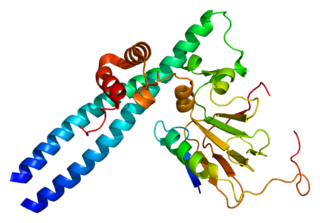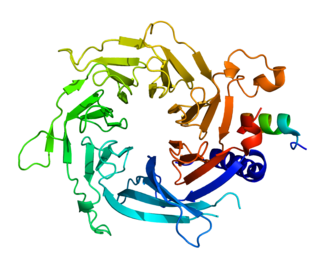
Histone acetyltransferase p300 also known as p300 HAT or E1A-associated protein p300 also known as EP300 or p300 is an enzyme that, in humans, is encoded by the EP300 gene. It functions as histone acetyltransferase that regulates transcription of genes via chromatin remodeling by allowing histone proteins to wrap DNA less tightly. This enzyme plays an essential role in regulating cell growth and division, prompting cells to mature and assume specialized functions (differentiate), and preventing the growth of cancerous tumors. The p300 protein appears to be critical for normal development before and after birth.

Cyclin-dependent kinase 4 also known as cell division protein kinase 4 is an enzyme that in humans is encoded by the CDK4 gene. CDK4 is a member of the cyclin-dependent kinase family.

Transcription factor E2F1 is a protein that in humans is encoded by the E2F1 gene.

Retinoblastoma-like protein 2 is a protein that in humans is encoded by the RBL2 gene.

The proto-oncogene c-Rel is a protein that in humans is encoded by the REL gene. The c-Rel protein is a member of the NF-κB family of transcription factors and contains a Rel homology domain (RHD) at its N-terminus and two C-terminal transactivation domains. c-Rel is a myeloid checkpoint protein that can be targeted for treating cancer. c-Rel has an important role in B-cell survival and proliferation. The REL gene is amplified or mutated in several human B-cell lymphomas, including diffuse large B-cell lymphoma and Hodgkin's lymphoma.

Histone-binding protein RBBP4 is a protein that in humans is encoded by the RBBP4 gene.

DNA-binding protein inhibitor ID-2 is a protein that in humans is encoded by the ID2 gene.

Cell division control protein 6 homolog is a protein that in humans is encoded by the CDC6 gene.

Histone-binding protein RBBP7 is a protein that in humans is encoded by the RBBP7 gene.

Retinoblastoma-like 1 (p107), also known as RBL1, is a protein that in humans is encoded by the RBL1 gene.

Protein kinase C eta type is an enzyme that in humans is encoded by the PRKCH gene.

Retinoblastoma-binding protein 8 is a protein that in humans is encoded by the RBBP8 gene.

HMG-box transcription factor 1, also known as HBP1, is a human protein.

60S ribosomal protein L11 is a protein that in humans is encoded by the RPL11 gene.

GA-binding protein subunit beta-1 is a protein that in humans is encoded by the GABPB1 gene.

Protein CREG1 is a protein that in humans is encoded by the CREG1 gene.

snRNA-activating protein complex subunit 1 is a protein that in humans is encoded by the SNAPC1 gene.

Zinc finger protein Gfi-1b is a protein that in humans is encoded by the GFI1B gene.

Docking protein 3 is a protein that in humans is encoded by the DOK3 gene.

The retinoblastoma protein is a tumor suppressor protein that is dysfunctional in several major cancers. One function of pRb is to prevent excessive cell growth by inhibiting cell cycle progression until a cell is ready to divide. When the cell is ready to divide, pRb is phosphorylated, inactivating it, and the cell cycle is allowed to progress. It is also a recruiter of several chromatin remodeling enzymes such as methylases and acetylases.






















